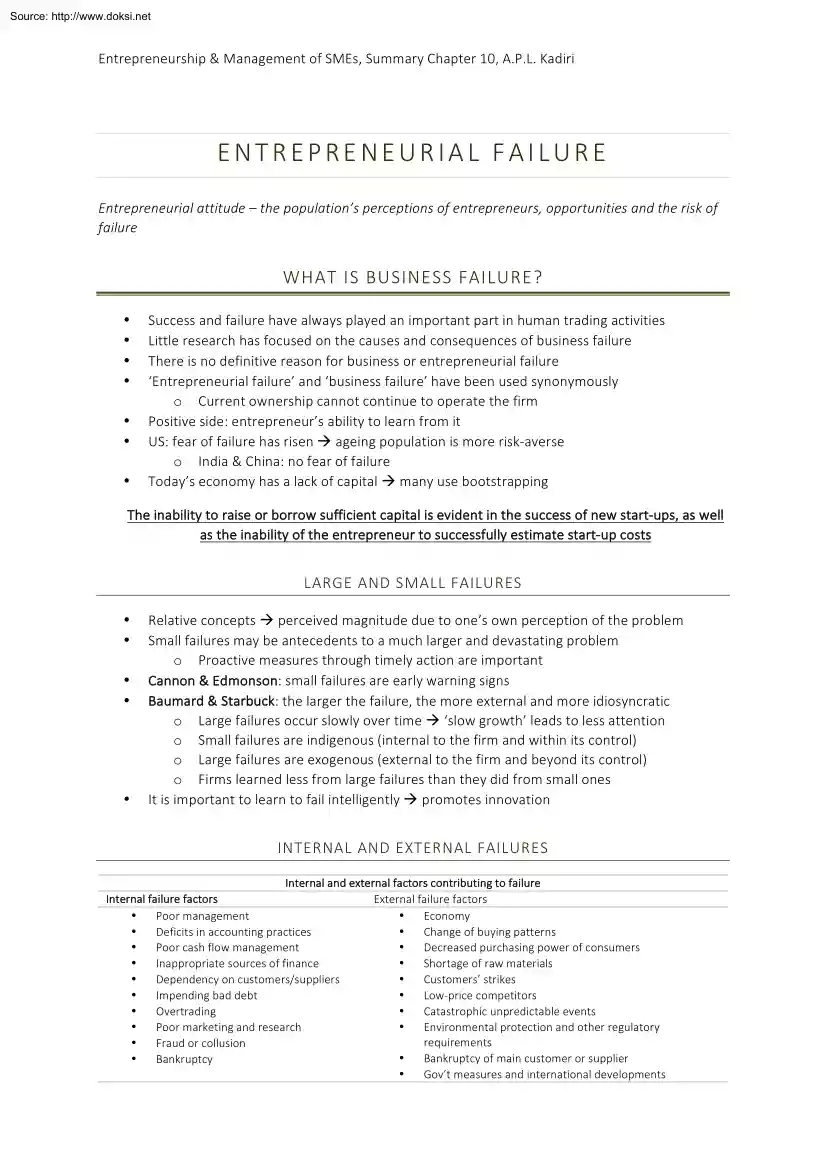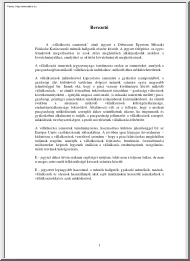Datasheet
Year, pagecount:2016, 3 page(s)
Language:English
Downloads:6
Uploaded:March 25, 2019
Size:1 MB
Institution:
-
Comments:
Attachment:-
Download in PDF:Please log in!
Comments
No comments yet. You can be the first!Most popular documents in this category
Content extract
Source: http://www.doksinet Entrepreneurship & Management of SMEs, Summary Chapter 10, A.PL Kadiri E N T R E P R E N E U R I A L F A I L U R E Entrepreneurial attitude – the population’s perceptions of entrepreneurs, opportunities and the risk of failure WHAT IS BUSINESS FAILURE? Success and failure have always played an important part in human trading activities Little research has focused on the causes and consequences of business failure There is no definitive reason for business or entrepreneurial failure ‘Entrepreneurial failure’ and ‘business failure’ have been used synonymously o Current ownership cannot continue to
operate the firm • Positive side: entrepreneur’s ability to learn from it • US: fear of failure has risen à ageing population is more risk-‐averse o India & China: no fear of failure • Today’s economy has a lack of capital à many use bootstrapping • • • • The inability to raise or borrow sufficient capital is evident in the success of new start-‐ups, as well as the inability of the entrepreneur to successfully estimate start-‐up costs LARGE AND SMALL FAILURES • Relative concepts à perceived magnitude due to one’s own perception of the
problem • Small failures may be antecedents to a much larger and devastating problem o Proactive measures through timely action are important • Cannon & Edmonson: small failures are early warning signs • Baumard & Starbuck: the larger the failure, the more external and more idiosyncratic o Large failures occur slowly over time à ‘slow growth’ leads to less attention o Small failures are indigenous (internal to the firm and within its control) o Large failures are exogenous (external to the firm and beyond its control) o Firms learned less from large failures than they
did from small ones • It is important to learn to fail intelligently à promotes innovation INTERNAL AND EXTERNAL FAILURES Internal and external factors contributing to failure Internal failure factors External failure factors • Poor management • Economy • Deficits in accounting practices • Change of buying patterns • Poor cash flow management • Decreased purchasing power of consumers • Inappropriate sources of finance • Shortage of raw materials • Dependency on customers/suppliers • Customers’ strikes • Impending bad debt • Low-‐price competitors • Overtrading • Catastrophic
unpredictable events • Poor marketing and research • Environmental protection and other regulatory requirements • Fraud or collusion • Bankruptcy of main customer or supplier • Bankruptcy • Gov’t measures and international developments Source: http://www.doksinet Entrepreneurship & Management of SMEs, Summary Chapter 10, A.PL Kadiri • There is no agreement on what exactly ‘bad management’ is • Many external factors are beyond the control of even the most capable entrepreneur • Some failed entrepreneurs ‘save face’ by attributing their failures to others o Often to external causes à make use
of attribution theory (Chapter 9) o Blame failures on exogenous factors and success on internal factors • Beaver: primary cause of business failure is an internal problem • Executive limit – a limit at which time the entrepreneur’s ability to lead the firm becomes harmful o Coordination and control problem • There is no clear and definite position available regarding internal and external failure ANTECEDENTS AND PERCEPTIONS OF BUSINESS FAILURE • One must ascertain what was occurring in the company prior to the event o Ignoring problems, blaming others etc. • Interview with
entrepreneurs: o ‘Not devoting enough timemaybe I need to devote myself more to my ventures’ o ‘Small problems that perhaps will ultimately lead to failure are ignored a great deal of time’ o ‘If we don’t use the small failures as steering mechanisms to change the vision or direction of the company, it will lead to catastrophic failure’ Entrepreneurs possess an ability to recognize and acknowledge antecedents to failure, yet they often choose to the early warning signs that these present ENTREPRENEURIAL RISK • Failure in business can be tied directly to the amount of
risk involved in the start-‐up or as the business grows • Research has mixed results for entrepreneurs’ views on risk: o Some say that entrepreneurs have the ability to use all of the talent at their disposal à utilize the best resources and networks à minimizing risk (risk-‐aversion) o Another concept of risk reduction à choosing an industry with less volatility o Risk denial – warning signs and actions that are not believed due to the priorities and values that are present and influence the interpretation of the signs o Others say that entrepreneurs engage in
risky behavior o Aversion to risk is much lower for individuals who are self-‐employed and more highly educated (inventors also have a low risk aversion) o Entrepreneurs have two diverse views on risk: 1. Viewing risk based on the variability of the returns an entrepreneur would expect from a new venture 2. ‘If this fails how much do I stand to lose? • Everyone will perceive an identical risk in differing ways • Numerous characteristics of an individual entrepreneur (age, family etc.) are indicated as factors that influence the risk propensity Source: http://www.doksinet
Entrepreneurship & Management of SMEs, Summary Chapter 10, A.PL Kadiri LIQUIDATION OR BANKRUPTCY • Bankruptcy or liquidation is one of the paths to failure or dissolution of a firm • Insolvency – the inability to pay one’s debt due to a lack of assets • US: controversy over the reporting of the frequency of small business bankruptcies à they have been plummeting à entrepreneur-‐friendly bankruptcy law o Thousand of business bankruptcies began to be classified as non-‐business bankruptcies à flawed record-‐keeping creates overconfidence and a lack of caution FEAR OF
FAILURE OR COMPARATIVE OPTIMISM • Comparative optimism – the tendency of people to report that they are less likely than others to experience negative events, and more likely than others to experience positive events o Overconfidence + lack of perception • Entrepreneurs want to continue to build new firms and all seem to be confident in their ability to do just that EXIT STRATEGIES • ‘Failure may lead to ultimate success in business by economizing on resources which leads to greater efficiencies’ o Exit strategy to maximize those efficiencies • Closures are sometimes mistakenly
thought to be failures • Business-‐owners have been to time their departure from businesses when the economy is on an upswing à in times of positively increasing economic activity, there will be an increase in business failures • It is important for entrepreneurs to design exit strategies that will allow them the flexibility to stop operations without losses o By utilizing an effective exit strategy, one can turn the perceived negative event into a positive one • All firms will eventually close for one reason or another (failure, closure, sell-‐out, bankruptcy) Important parts of
designing and creating a successful firm is to also design a workable exit strategy at the beginning of the start-‐up process
operate the firm • Positive side: entrepreneur’s ability to learn from it • US: fear of failure has risen à ageing population is more risk-‐averse o India & China: no fear of failure • Today’s economy has a lack of capital à many use bootstrapping • • • • The inability to raise or borrow sufficient capital is evident in the success of new start-‐ups, as well as the inability of the entrepreneur to successfully estimate start-‐up costs LARGE AND SMALL FAILURES • Relative concepts à perceived magnitude due to one’s own perception of the
problem • Small failures may be antecedents to a much larger and devastating problem o Proactive measures through timely action are important • Cannon & Edmonson: small failures are early warning signs • Baumard & Starbuck: the larger the failure, the more external and more idiosyncratic o Large failures occur slowly over time à ‘slow growth’ leads to less attention o Small failures are indigenous (internal to the firm and within its control) o Large failures are exogenous (external to the firm and beyond its control) o Firms learned less from large failures than they
did from small ones • It is important to learn to fail intelligently à promotes innovation INTERNAL AND EXTERNAL FAILURES Internal and external factors contributing to failure Internal failure factors External failure factors • Poor management • Economy • Deficits in accounting practices • Change of buying patterns • Poor cash flow management • Decreased purchasing power of consumers • Inappropriate sources of finance • Shortage of raw materials • Dependency on customers/suppliers • Customers’ strikes • Impending bad debt • Low-‐price competitors • Overtrading • Catastrophic
unpredictable events • Poor marketing and research • Environmental protection and other regulatory requirements • Fraud or collusion • Bankruptcy of main customer or supplier • Bankruptcy • Gov’t measures and international developments Source: http://www.doksinet Entrepreneurship & Management of SMEs, Summary Chapter 10, A.PL Kadiri • There is no agreement on what exactly ‘bad management’ is • Many external factors are beyond the control of even the most capable entrepreneur • Some failed entrepreneurs ‘save face’ by attributing their failures to others o Often to external causes à make use
of attribution theory (Chapter 9) o Blame failures on exogenous factors and success on internal factors • Beaver: primary cause of business failure is an internal problem • Executive limit – a limit at which time the entrepreneur’s ability to lead the firm becomes harmful o Coordination and control problem • There is no clear and definite position available regarding internal and external failure ANTECEDENTS AND PERCEPTIONS OF BUSINESS FAILURE • One must ascertain what was occurring in the company prior to the event o Ignoring problems, blaming others etc. • Interview with
entrepreneurs: o ‘Not devoting enough timemaybe I need to devote myself more to my ventures’ o ‘Small problems that perhaps will ultimately lead to failure are ignored a great deal of time’ o ‘If we don’t use the small failures as steering mechanisms to change the vision or direction of the company, it will lead to catastrophic failure’ Entrepreneurs possess an ability to recognize and acknowledge antecedents to failure, yet they often choose to the early warning signs that these present ENTREPRENEURIAL RISK • Failure in business can be tied directly to the amount of
risk involved in the start-‐up or as the business grows • Research has mixed results for entrepreneurs’ views on risk: o Some say that entrepreneurs have the ability to use all of the talent at their disposal à utilize the best resources and networks à minimizing risk (risk-‐aversion) o Another concept of risk reduction à choosing an industry with less volatility o Risk denial – warning signs and actions that are not believed due to the priorities and values that are present and influence the interpretation of the signs o Others say that entrepreneurs engage in
risky behavior o Aversion to risk is much lower for individuals who are self-‐employed and more highly educated (inventors also have a low risk aversion) o Entrepreneurs have two diverse views on risk: 1. Viewing risk based on the variability of the returns an entrepreneur would expect from a new venture 2. ‘If this fails how much do I stand to lose? • Everyone will perceive an identical risk in differing ways • Numerous characteristics of an individual entrepreneur (age, family etc.) are indicated as factors that influence the risk propensity Source: http://www.doksinet
Entrepreneurship & Management of SMEs, Summary Chapter 10, A.PL Kadiri LIQUIDATION OR BANKRUPTCY • Bankruptcy or liquidation is one of the paths to failure or dissolution of a firm • Insolvency – the inability to pay one’s debt due to a lack of assets • US: controversy over the reporting of the frequency of small business bankruptcies à they have been plummeting à entrepreneur-‐friendly bankruptcy law o Thousand of business bankruptcies began to be classified as non-‐business bankruptcies à flawed record-‐keeping creates overconfidence and a lack of caution FEAR OF
FAILURE OR COMPARATIVE OPTIMISM • Comparative optimism – the tendency of people to report that they are less likely than others to experience negative events, and more likely than others to experience positive events o Overconfidence + lack of perception • Entrepreneurs want to continue to build new firms and all seem to be confident in their ability to do just that EXIT STRATEGIES • ‘Failure may lead to ultimate success in business by economizing on resources which leads to greater efficiencies’ o Exit strategy to maximize those efficiencies • Closures are sometimes mistakenly
thought to be failures • Business-‐owners have been to time their departure from businesses when the economy is on an upswing à in times of positively increasing economic activity, there will be an increase in business failures • It is important for entrepreneurs to design exit strategies that will allow them the flexibility to stop operations without losses o By utilizing an effective exit strategy, one can turn the perceived negative event into a positive one • All firms will eventually close for one reason or another (failure, closure, sell-‐out, bankruptcy) Important parts of
designing and creating a successful firm is to also design a workable exit strategy at the beginning of the start-‐up process





